Interannual Variation of Summer Sea Surface Salinity in the Dotson–Getz Trough, West Antarctica
Abstract
:1. Introduction
2. Data and Methods
2.1. Collection of Salinity Data
2.2. Calculation of the Total Ocean Surface Stress
3. Results
3.1. Assessment of the EN4 Dataset’s Veracity
3.2. Interannual Variations in SSS along the DGT
3.3. Correlations of Surface Salinity with Surface Freshwater Flux
3.4. Correlations of Surface Salinity with SIC
3.5. Correlations of Surface Salinity with Surface Stress Curl
4. Conclusions
Author Contributions
Funding
Institutional Review Board Statement
Informed Consent Statement
Data Availability Statement
Acknowledgments
Conflicts of Interest
References
- Nitsche, F.O.; Jacobs, S.S.; Larter, R.D.; Gohl, K. Bathymetry of the Amundsen Sea continental shelf: Implications for geology, oceanography, and glaciology. Geochem. Geophys. Geosyst. 2007, 8, 1–10. [Google Scholar] [CrossRef]
- Heywood, K.; Biddle, L.; Boehme, L.; Dutrieux, P.; Fedak, M.; Jenkins, A.; Jones, R.; Kaiser, J.; Mallett, H.; Garabato, A.N.; et al. Between the Devil and the Deep Blue Sea: The role of the Amundsen Sea continental shelf in exchange between ocean and ice shelves. Oceanography 2016, 29, 118–129. [Google Scholar] [CrossRef]
- Yu, L.S.; He, H.; Leng, H.; Liu, H.; Lin, P. Interannual variation of summer sea surface temperature in the Amundsen Sea, Antarctica. Front. Mar. Sci. 2023, 10, 1050955. [Google Scholar] [CrossRef]
- Arneborg, L.; Wåhlin, A.K.; Björk, G.; Liljebladh, B.; Orsi, A.H. Persistent inflow of warm water onto the central Amundsen shelf. Nat. Geosci. 2012, 5, 876–880. [Google Scholar] [CrossRef]
- Ha, H.K.; Wåhlin, A.K.; Kim, T.W.; Lee, S.H.; Lee, J.H.; Lee, H.J.; Hong, C.S.; Arneborg, L.; Björk, G.; Kalén, O. Circulation and modification of warm deep water on the central Amundsen Shelf. J. Phys. Oceanogr. 2014, 44, 1493–1501. [Google Scholar] [CrossRef]
- Kim, C.-S.; Kim, T.-W.; Cho, K.-H.; Ha, H.K.; Lee, S.; Kim, H.-C.; Lee, J.-H. Variability of the Antarctic Coastal Current in the Amundsen Sea. Estuar. Coast. Shelf Sci. 2016, 181, 123–133. [Google Scholar] [CrossRef]
- Jenkins, A.; Shoosmith, D.; Dutrieux, P.; Jacobs, S.; Kim, T.W.; Lee, S.H.; Ha, H.K.; Stammerjohn, S. West Antarctic ice sheet retreat in the Amundsen Sea driven by decadal oceanic variability. Nat. Geosci. 2018, 11, 733–738. [Google Scholar] [CrossRef]
- Min, J.O.; Kim, S.H.; Jung, J.; Jung, U.J.; Yang, E.J.; Lee, S.; Hyun, J.H. Glacial ice melting stimulates heterotrophic prokaryotes production on the Getz Ice Shelf in the Amundsen Sea, Antarctica. Geophys. Res. Lett. 2022, 49, e2021GL097627. [Google Scholar] [CrossRef]
- Caillet, J.; Jourdain, N.C.; Mathiot, P.; Hellmer, H.H.; Mouginot, J. Drivers and reversibility of abrupt ocean state transitions in the Amundsen Sea, Antarctica. J. Geophys. Res. Ocean. 2023, 128, e2022JC018929. [Google Scholar] [CrossRef]
- Gravalosa, J.M.; Flores, J.-A.; Sierro, F.J.; Gersonde, R. Sea surface distribution of coccolithophores in the eastern Pacific sector of the Southern Ocean (Bellingshausen and Amundsen Seas) during the late austral summer of 2001. Mar. Micropaleontol. 2008, 69, 16–25. [Google Scholar] [CrossRef]
- Lee, Y.; Yang, E.J.; Park, J.; Jung, J.; Kim, T.W.; Lee, S. Physical-biological coupling in the Amundsen Sea, Antarctica: Influence of physical factors on phytoplankton community structure and biomass. Deep. Sea Res. Part I Oceanogr. Res. Pap. 2016, 117, 51–60. [Google Scholar] [CrossRef]
- Garcia, C.; Comiso, J.C.; Berkelhammer, M.; Stock, L. Interrelationships of Sea Surface Salinity, Chlorophyll-α Concentration, and Sea Surface Temperature near the Antarctic Ice Edge. J. Clim. 2021, 34, 6069–6086. [Google Scholar] [CrossRef]
- Helm, K.P.; Bindoff, N.L.; Church, J.A. Changes in the global hydrological-cycle inferred from ocean salinity. Geophys. Res. Lett. 2010, 37, L18701. [Google Scholar] [CrossRef]
- Lagerloef, G.S. Introduction to the special section: The role of surface salinity on upper ocean dynamics, air-sea interaction and climate. J. Geophys. Res. Ocean. 2002, 107, SRF-1. [Google Scholar] [CrossRef]
- Reul, N.; Fournier, S.; Boutin, J.; Hernandez, O.; Maes, C.; Chapron, B.; Alory, G.; Quilfen, Y.; Tenerelli, J.; Morisset, S.; et al. Sea Surface Salinity Observations from Space with the SMOS Satellite: A New Means to Monitor the Marine Branch of the Water Cycle. Surv. Geophys. 2014, 35, 681–722. [Google Scholar] [CrossRef]
- Durack, P.J. Ocean salinity and the global water cycle. Oceanography 2015, 28, 20–31. [Google Scholar] [CrossRef]
- Alderkamp, A.C.; Mills, M.M.; van Dijken, G.L.; Laan, P.; Thuroczy, C.E.; Gerringa, L.J.; de Baar, H.J.; Payne, C.D.; Visser, R.J.; Buma, A.G.; et al. Iron from melting glaciers fuels phytoplankton blooms in the Amundsen Sea (Southern Ocean): Phytoplankton characteristics and productivity. Deep. Sea Res. Part II Top. Stud. Oceanogr. 2012, 71, 32–48. [Google Scholar] [CrossRef]
- Rintoul, S.R.; Silvano, A.; Pena-Molino, B.; van Wijk, E.; Rosenberg, M.; Greenbaum, J.S.; Blankenship, D.D. Ocean heat drives rapid basal melt of the Totten Ice Shelf. Sci. Adv. 2016, 2, e1601610. [Google Scholar] [CrossRef]
- Turner, J.; Lu, H.; White, I.; King, J.C.; Phillips, T.; Hosking, J.S.; Bracegirdle, T.; Marshall, G.J.; Mulvaney, R.; Deb, P. Absence of 21st century warming on Antarctic Peninsula consistent with natural variability. Nature 2016, 535, 411–415. [Google Scholar] [CrossRef]
- Randall-Goodwin, E.; Meredith, M.P.; Jenkins, A.; Yager, P.L.; Sherrell, R.M.; Abrahamsen, E.P.; Guerrero, R.; Yuan, X.; Mortlock, R.A.; Gavahan, K.; et al. Freshwater distributions and water mass structure in the Amundsen Sea Polynya region, Antarctica. Elem. Sci. Anthr. 2015, 3, 000065. [Google Scholar] [CrossRef]
- Kim, T.-W.; Yang, H.W.; Dutrieux, P.; Wåhlin, A.K.; Jenkins, A.; Kim, Y.G.; Ha, H.K.; Kim, C.-S.; Cho, K.-H.; Park, T.; et al. Interannual variation of modified circumpolar deep water in the Dotson-Getz Trough, West Antarctica. J. Geophys. Res. Ocean. 2021, 126, e2021JC017491. [Google Scholar] [CrossRef]
- Shin, D.Y.; Hahm, D.; Kim, T.-W.; Rhee, T.S.; Lee, S.H.; Park, K.; Park, J.; Kwon, Y.S.; Kim, M.S.; Lee, T. Identification of ventilated and submarine glacial meltwaters in the Amundsen Sea, Antarctica, using noble gases. Front. Mar. Sci. 2022, 9, 951471. [Google Scholar] [CrossRef]
- He, H.L.; Wu, S.C. Comparison of ship-based CTD measurement of Circumpolar Deep Water in the Amundsen Sea based on World Ocean Database. Adv. Polar Sci. 2022, 33, 145–155. [Google Scholar]
- Good, S.A.; Martin, M.J.; Rayner, N.A. EN4: Quality controlled ocean temperature and salinity profiles and monthly objective analyses with uncertainty estimates. J. Geophys. Res. Oceans 2013, 118, 6704–6716. [Google Scholar] [CrossRef]
- Schaffer, J.; Timmermann, R.; Arndt, J.E.; Kristensen, S.S.; Mayer, C.; Morlighem, M.; Steinhage, D. A global, high-resolution data set of ice sheet topography, cavity geometry, and ocean bathymetry. Earth Syst. Sci. Data 2016, 8, 543–557. [Google Scholar] [CrossRef]
- Tsamados, M.; Feltham, D.L.; Schroeder, D.; Flocco, D.; Farrell, S.L.; Kurtz, N.; Laxon, S.W.; Bacon, S. Impact of Variable Atmospheric and Oceanic Form Drag on Simulations of Arctic Sea Ice. J. Phys. Oceanogr. 2014, 44, 1329–1353. [Google Scholar] [CrossRef]
- Hersbach, H.; Bell, B.; Berrisford, P.; Biavati, G.; Horányi, A.; Muñoz Sabater, J.; Nicolas, J.; Peubey, C.; Radu, R.; Rozum, I.; et al. ERA5 Monthly Averaged Data on Single Levels from 1940 to Present. Copernicus Climate Change Service (C3S) Climate Data Store (CDS). 2023. Available online: https://cds.climate.copernicus.eu/cdsapp#!/dataset/reanalysis-era5-single-levels-monthly-means?tab=overview (accessed on 15 May 2024). [CrossRef]
- Meier, W.N.; Fetterer, F.; Windnagel, A.K.; Stewart, J.S. NOAA/NSIDC Climate Data Record of Passive Microwave Sea Ice Concentration, Version 4 [Data Set]; National Snow and Ice Data Center: Boulder, CO, USA, 2021. [Google Scholar]
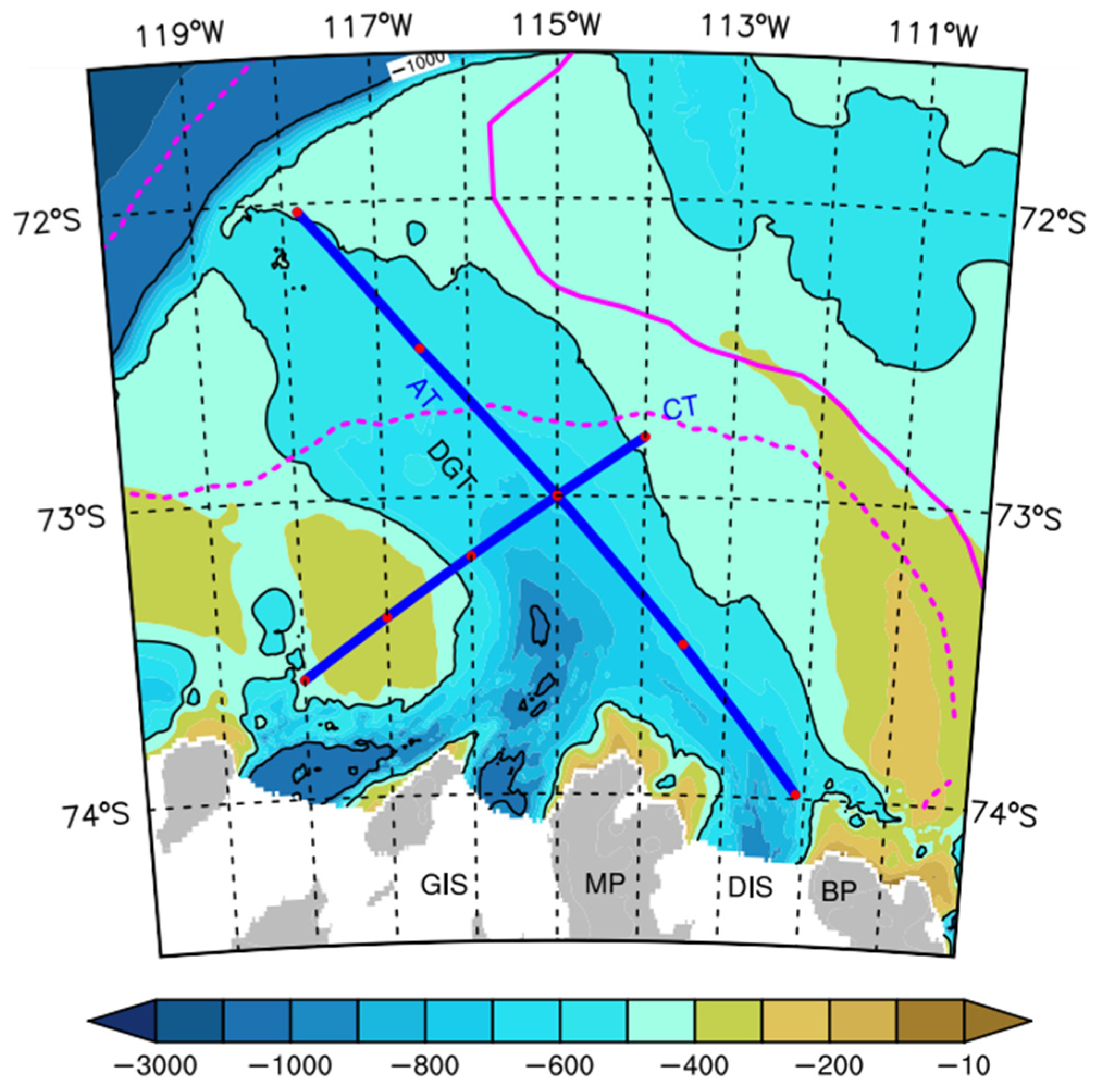
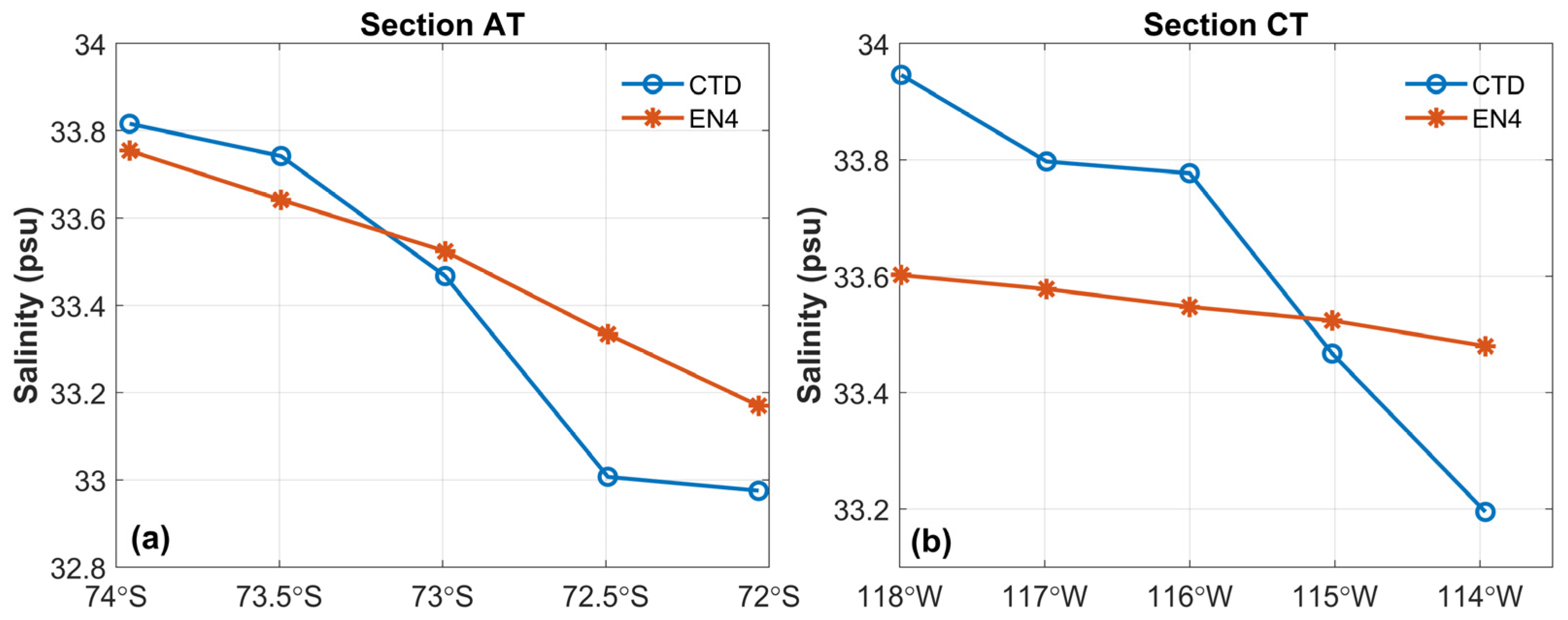



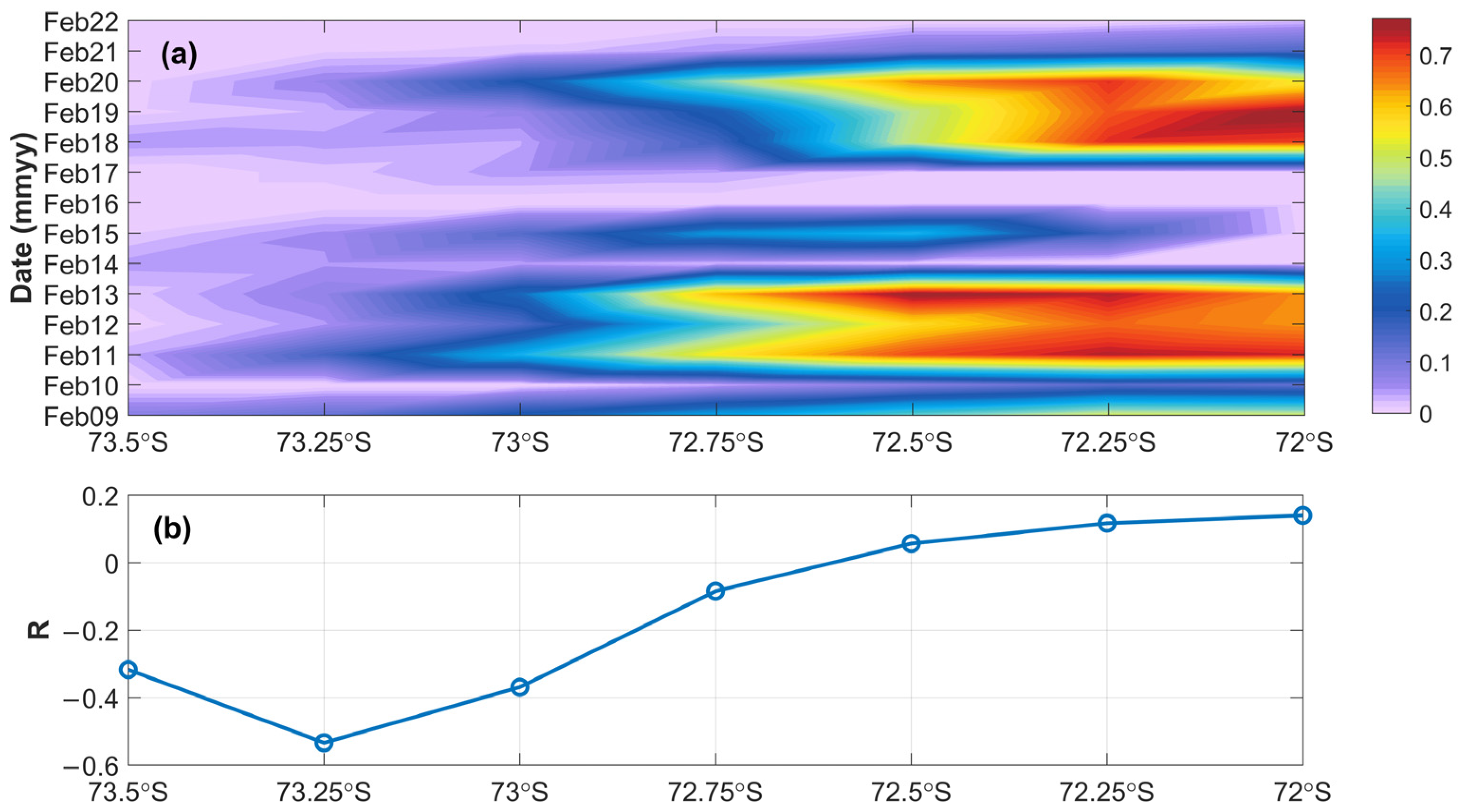
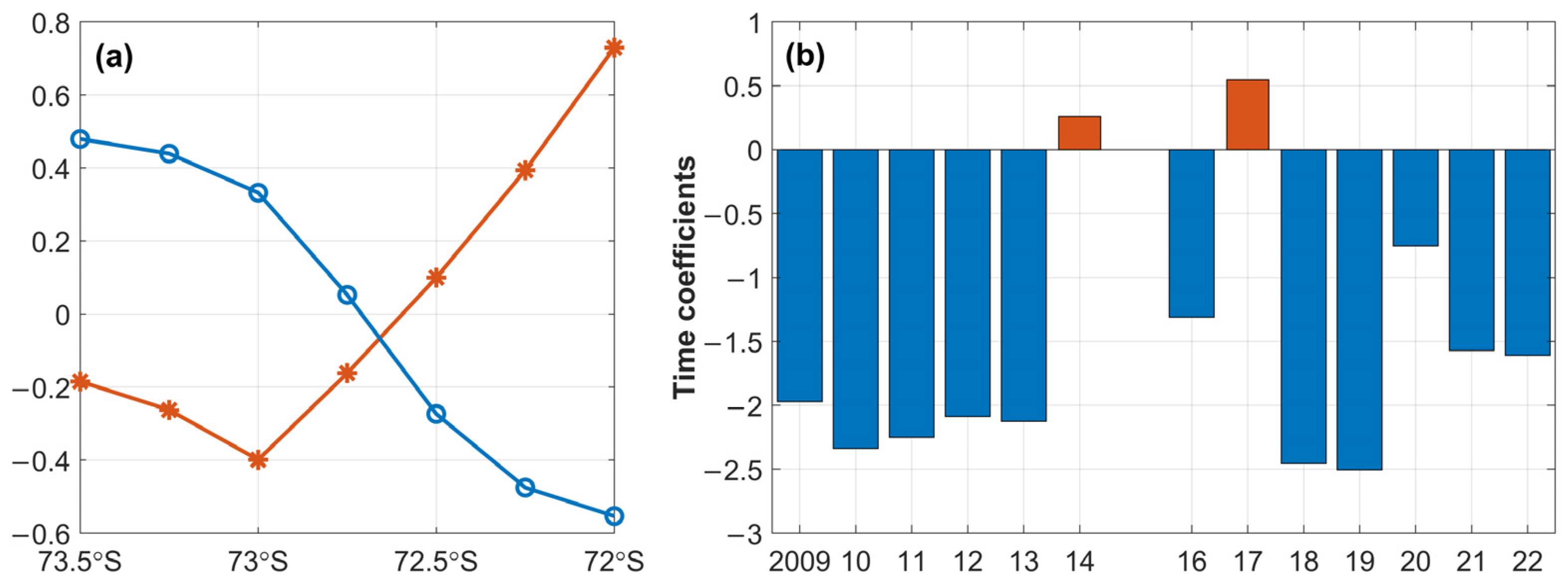

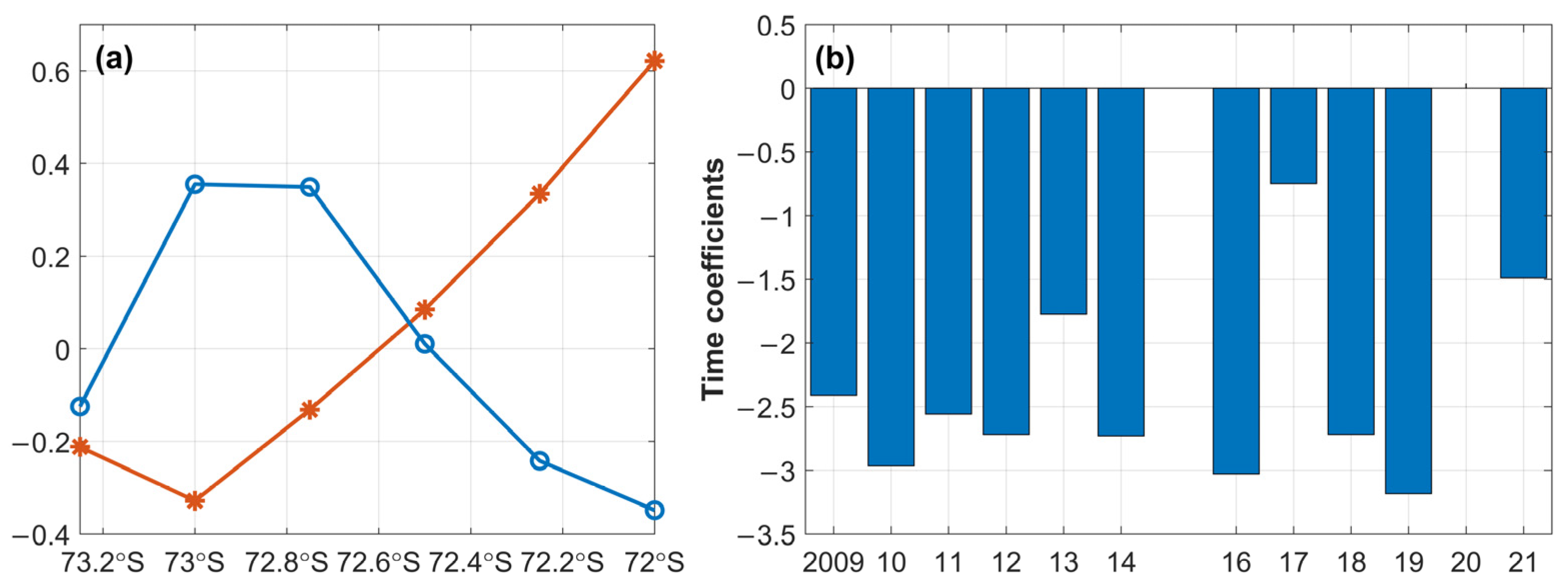
Disclaimer/Publisher’s Note: The statements, opinions and data contained in all publications are solely those of the individual author(s) and contributor(s) and not of MDPI and/or the editor(s). MDPI and/or the editor(s) disclaim responsibility for any injury to people or property resulting from any ideas, methods, instructions or products referred to in the content. |
© 2024 by the authors. Licensee MDPI, Basel, Switzerland. This article is an open access article distributed under the terms and conditions of the Creative Commons Attribution (CC BY) license (https://creativecommons.org/licenses/by/4.0/).
Share and Cite
Yu, L.-S.; He, H.; Leng, H.; Chen, X. Interannual Variation of Summer Sea Surface Salinity in the Dotson–Getz Trough, West Antarctica. J. Mar. Sci. Eng. 2024, 12, 1067. https://doi.org/10.3390/jmse12071067
Yu L-S, He H, Leng H, Chen X. Interannual Variation of Summer Sea Surface Salinity in the Dotson–Getz Trough, West Antarctica. Journal of Marine Science and Engineering. 2024; 12(7):1067. https://doi.org/10.3390/jmse12071067
Chicago/Turabian StyleYu, Lu-Sha, Hailun He, Hengling Leng, and Xiaohui Chen. 2024. "Interannual Variation of Summer Sea Surface Salinity in the Dotson–Getz Trough, West Antarctica" Journal of Marine Science and Engineering 12, no. 7: 1067. https://doi.org/10.3390/jmse12071067




